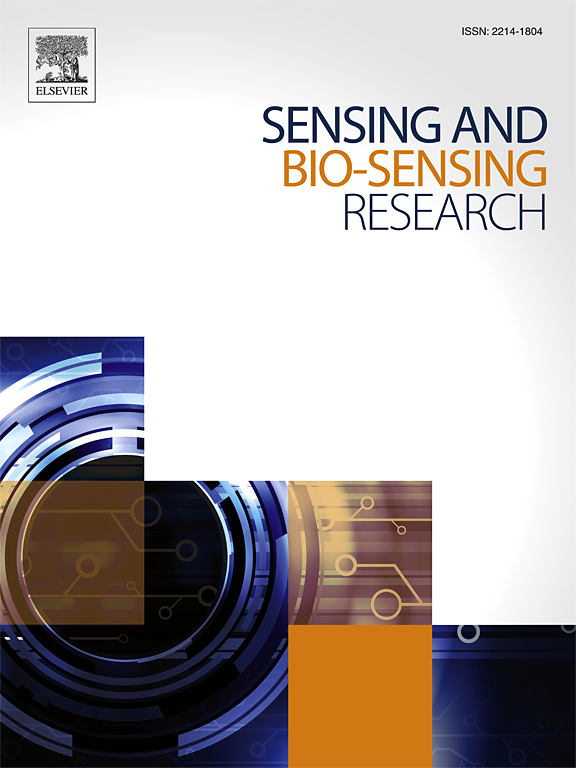Carbon dots: Review of recent applications and perspectives in bio-sensing and biomarker detection
IF 5.4
Q1 CHEMISTRY, ANALYTICAL
引用次数: 0
Abstract
Carbon Dots (CDs) are carbon-based nanoparticles with relatively strong and tunable fluorescence emission properties and relatively good photo stability, which are increasingly used in sensing and biosensing as reported in hundreds of research publications. There are 4 types of CD-based sensors or detection (CD-only, CD-based Enzymatic, CD-based Antigen-Antibody modified, CD-based Nucleic acid biosensors) that will be described and compared in this review. Such analytical parameters as Limit of Detection (LOD), linear range, Relative Standard Deviation (RSD) are compared and discussed in this review. Median and/or average LOD, RSD, Linear Range are calculated and presented in multiple tables, while LODs are tabulated from 135 references. Among these biosensors, CD-based Nucleic Acid biosensors and CD-based Antibody-Antigen biosensors show better sensitivity (lower LOD) when compared with CD-only and CD-based Enzymatic biosensors. Four main groups of detection techniques applicable, such as fluorescence, electrochemical, colorimetry, and electrochemiluminescence methods are considered and compared for CD-based Antibody-Antigen biosensors descriptions. Perspectives of machine learning methods and smart phones as read out devices for CD-based bio-sensors are outlined in the conclusion of the review. We also briefly described and illustrated with graphic examples/figures some basic phenomena related to CD-based sensing, including CD doping, up-conversion, modification and immobilization of CDs, quenching and FRET.

碳点:在生物传感和生物标志物检测中的最新应用及展望
碳点(cd)是一种具有较强的可调荧光发射特性和较好的光稳定性的碳基纳米颗粒,在传感和生物传感领域的应用越来越广泛,已有数百篇研究论文报道。有4种类型的基于cd的传感器或检测(CD-only, CD-based Enzymatic, CD-based Antigen-Antibody modified, CD-based Nucleic acid biosensors)将在本文中进行描述和比较。本文对检测限(LOD)、线性范围(linear range)、相对标准偏差(Relative Standard Deviation)等分析参数进行了比较和讨论。LOD的中位数和/或平均值、RSD、线性范围在多个表中计算和呈现,而LOD则由135篇参考文献制成。在这些生物传感器中,基于cd的核酸生物传感器和基于cd的抗体抗原生物传感器与仅基于cd和基于cd的酶生物传感器相比,具有更高的灵敏度(更低的LOD)。四组主要适用的检测技术,如荧光,电化学,比色法和电化学发光方法被考虑和比较了基于cd的抗体-抗原生物传感器的描述。在综述的结论中概述了机器学习方法和智能手机作为基于cd的生物传感器读出设备的前景。本文还简要介绍并举例说明了与CD传感相关的一些基本现象,包括CD掺杂、上转换、改性和固定化、淬火和FRET。
本文章由计算机程序翻译,如有差异,请以英文原文为准。
求助全文
约1分钟内获得全文
求助全文
来源期刊

Sensing and Bio-Sensing Research
Engineering-Electrical and Electronic Engineering
CiteScore
10.70
自引率
3.80%
发文量
68
审稿时长
87 days
期刊介绍:
Sensing and Bio-Sensing Research is an open access journal dedicated to the research, design, development, and application of bio-sensing and sensing technologies. The editors will accept research papers, reviews, field trials, and validation studies that are of significant relevance. These submissions should describe new concepts, enhance understanding of the field, or offer insights into the practical application, manufacturing, and commercialization of bio-sensing and sensing technologies.
The journal covers a wide range of topics, including sensing principles and mechanisms, new materials development for transducers and recognition components, fabrication technology, and various types of sensors such as optical, electrochemical, mass-sensitive, gas, biosensors, and more. It also includes environmental, process control, and biomedical applications, signal processing, chemometrics, optoelectronic, mechanical, thermal, and magnetic sensors, as well as interface electronics. Additionally, it covers sensor systems and applications, µTAS (Micro Total Analysis Systems), development of solid-state devices for transducing physical signals, and analytical devices incorporating biological materials.
 求助内容:
求助内容: 应助结果提醒方式:
应助结果提醒方式:


